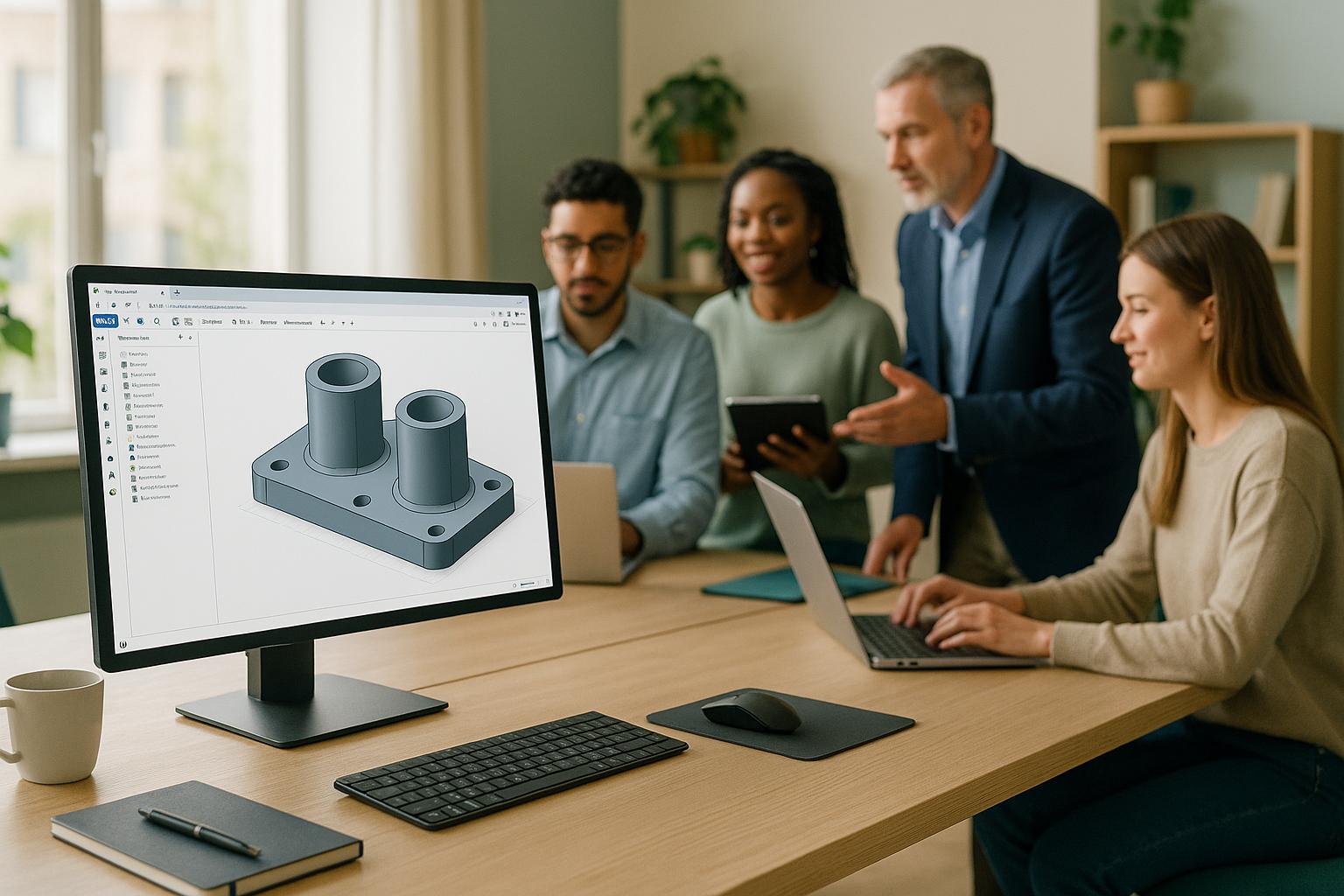Building an MVP in 90 days is possible – even without technical skills. Here’s how:
- Plan Smartly: Focus on solving one key problem with a few core features. Split your timeline into 4 phases: research (15 days), design (15 days), development (45 days), and testing (15 days).
- Use No-Code Tools: Platforms like Bubble, Webflow, and Glide let you build functional products without coding. Pick tools based on your product needs, budget, and scalability.
- Outsource Wisely: If needed, hire developers with proven experience. Set clear goals, track progress, and maintain strong communication.
- Validate and Iterate: Test your MVP with users, gather feedback, and improve based on their input.
This guide helps you stay focused, use efficient tools, and launch a product that meets user needs – all in just 90 days.
Related video from YouTube
1: Planning Your 90-Day MVP Development Strategy
A clear plan is the backbone of any successful MVP launch. For non-tech founders, having a structured approach ensures you stay focused on the most important features and meet your 90-day deadline. This plan will also guide your choices in tools (discussed in Section 2) and how you manage your team.
Setting Clear Goals and Objectives
Define specific and measurable goals that align with your business vision. Your MVP should zero in on solving a key problem and delivering something meaningful to your users. Instead of cramming in features, stick to the essentials that support your main purpose.
Here’s a framework to help you set your goals:
| Component | Example |
|---|---|
| Specific | Reduce checkout time by 30% |
| Measurable | Track user engagement rates |
| Achievable | Launch with 3 core features |
| Relevant | Focus on key user pain points |
| Time-bound | Complete testing by day 75 |
Prioritizing Core Features
Deciding which features to build is critical for hitting your 90-day target. Focus on the must-haves that address your users’ primary needs. Avoid the urge to add extras that might slow you down.
Use this simple prioritization guide:
| Priority Level | Feature Type | Timeline |
|---|---|---|
| Critical | Core functionality | Days 1-45 |
| Important | Essential support | Days 46-70 |
| Optional | Nice-to-have features | Post-MVP |
Creating a 90-Day Timeline
Divide your 90 days into manageable phases. This timeline helps you stay organized and keep progress on track. Here’s how you can break it down:
-
Discovery Phase (Days 1-15)
Dive into market research, conduct user interviews, and analyze competitors. This step sharpens your product vision and validates your assumptions. -
Design and Planning (Days 16-30)
Develop wireframes, map out user flows, and create technical specifications. Set clear milestones and deliverables for each sprint to streamline communication and avoid confusion. -
Development Sprints (Days 31-75)
Split development into two-week sprints, tackling one core feature at a time. Regular check-ins ensure you’re staying on schedule. -
Testing and Iteration (Days 76-90)
Test your MVP with users and make adjustments based on their feedback. This phase ensures your product delivers real value.
2: Using No-Code and Low-Code Tools
No-code and low-code platforms have changed the game for MVP development. They let non-technical founders create functional products without needing to write any code. These platforms use drag-and-drop interfaces and pre-built components, making the development process much faster.
Popular No-Code/Low-Code Platforms
The platform you choose should match the type of MVP you’re building. For example, Bubble is great for complex web apps, Webflow shines in visual design, and Glide turns spreadsheets into mobile apps.
| Platform | Best For | Key Features | Typical Use Case |
|---|---|---|---|
| Bubble | Web Applications | Complex workflows, database management | SaaS products, marketplaces |
| Webflow | Visual Design | CMS integration, responsive design | E-commerce sites, portfolios |
| Glide | Mobile Apps | Spreadsheet-based, quick deployment | Internal tools, simple apps |
These platforms help bridge the technical skills gap, allowing you to focus on testing and refining your core idea.
Choosing the Right Tools for Your MVP
To pick the best platform, consider these three factors:
| Factor | Key Question |
|---|---|
| Product Needs | Does it support the features you need? |
| Budget | What’s the total cost? |
| Growth | Can it scale as your user base grows? |
The features you prioritized in Section 1 will guide your choice, ensuring everything aligns with your 90-day timeline.
Tips for Using No-Code Tools Efficiently
-
Start with Templates
Allocate 5–10 days in your timeline (as mentioned in Section 1) for customizing templates. This approach saves weeks compared to building everything from scratch. -
Leverage Integrations
Connect your MVP with essential tools and services. Platforms like Zapier can automate workflows between different apps, saving time and effort. -
Focus on Core Features
Stick to the critical features outlined in your 90-day plan (Section 1). Use user behavior and engagement data to guide future updates and improvements.
sbb-itb-51b9a02
3: Outsourcing MVP Development
For non-technical founders aiming to launch an MVP efficiently, outsourcing development can be a smart move. It allows you to tap into expert skills while staying focused on your business goals.
Pros and Cons of Outsourcing
Before choosing to outsource, weigh these important factors:
| Aspect | Advantages | Disadvantages |
|---|---|---|
| Technical Expertise | Access to skilled developers immediately | Onboarding challenges may arise |
| Development Speed | Faster delivery with dedicated teams | Possible delays due to time zone gaps |
| Cost Management | Lower overhead and infrastructure costs | Upfront costs might exceed expectations |
| Project Control | Use of professional management systems | Limited direct oversight of progress |
| Scalability | Access to extra resources when needed | Potential integration issues |
To get the most out of outsourcing while avoiding pitfalls, choosing the right partner is key.
Choosing a Development Partner
When selecting a partner, focus on these criteria:
| Evaluation Criteria | What to Look For |
|---|---|
| Technical Expertise | Experience with similar MVPs and tech stacks |
| Portfolio Quality | Proven success in your industry or similar scope |
| Communication Style | Clear and responsive project management |
| Development Process | Structured workflows with regular milestones |
| 90-Day Alignment | Ability to deliver within tight deadlines |
Managing an Outsourced Team
To keep your project on track, follow these practices:
- Set Clear Communication Protocols: Use project management tools for daily updates and decision tracking.
- Maintain Detailed Documentation: Keep requirement documents and decision logs to ensure everyone stays aligned.
-
Track Progress Actively: Monitor development using metrics like:
- Feature completion rates
- Bug resolution times
- Development speed
- Implementation of user feedback
Success in outsourcing goes beyond finding the right partner. It’s about building a solid collaboration framework that aligns with your MVP goals from the start.
4: Validating Your MVP and Iterating
Validating your MVP within 90 days means taking a focused approach to testing and acting on user feedback.
Early User Testing Strategies
Getting the right early adopters on board is key to collecting feedback that matters. Here are some effective testing methods to guide your process:
| Testing Method | Purpose | Phase Alignment |
|---|---|---|
| Landing Page Testing | Gauge interest and validate the concept | Discovery Phase |
| User Interviews | Gather detailed feedback | Design Phase |
| Usability Testing | Evaluate interface and experience | Development Sprint 1 |
| Beta Testing | Confirm core features | Development Sprint 2 |
For example, Buffer used a simple landing page to measure market demand before building any features. This approach helped them gain early traction quickly.
These methods naturally tie into your feedback collection process, which we’ll structure for the best results.
Collecting and Analyzing Feedback
Since 45% of product managers prioritize customer feedback when making decisions [1], having a solid system for gathering and analyzing input is crucial. Here’s how to break it down:
| Feedback Type | Method & Analysis |
|---|---|
| Quantitative Data | Use analytics to track usage patterns |
| Qualitative Input | Conduct interviews to uncover pain points |
| Behavioral Data | Analyze session recordings for user interactions |
Iterating Based on Feedback
Using the core features you prioritized in Section 1, turn feedback into actionable updates within your 90-day timeframe. For instance, a productivity app founder boosted conversion rates by 40% after addressing onboarding issues suggested by users.
Focus your iterations on these areas:
- Addressing major user blockers
- Filling gaps in core functionality
- Resolving UX friction points
Conclusion: Key Points for Building an MVP in 90 Days
Breaking Down the 90-Day MVP Development Process
Creating a successful MVP involves three essential stages: planning, execution, and validation. The first 30 days focus on careful planning, setting clear goals, and mapping out the product. From Days 31 to 75, the focus shifts to execution, using the right tools or collaborating with skilled partners. Finally, Days 76 to 90 are all about validation – testing the product with real users and gathering feedback.
What Non-Tech Founders Should Do Next
After launching your MVP, keeping the momentum is crucial. Here’s how to move forward:
- Track Key Metrics: Keep an eye on user engagement and retention to confirm whether your product meets market needs.
- Refine Your Approach: Improve your use of no-code tools and outsourcing methods to enhance efficiency.
- Plan for Growth: Use your original feature prioritization framework to scale your product thoughtfully.









Leave a Reply